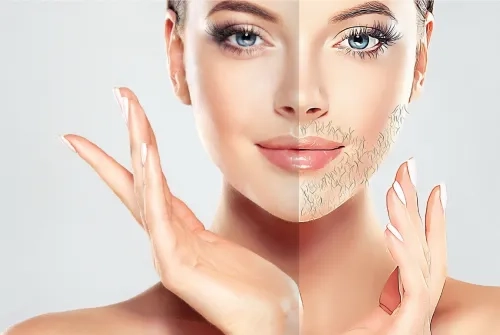Alo Yeditepe
Alo Yeditepe
What is Hirsutism?
In women, Hirsutism, defined as male pattern hair removal, is a clinical finding resulting from increased androgen hormone production or sensitivity to androgen hormones. In addition to normal hair growth, which is called quince hair on the face and body, hard, dark colored dense hair growth is observed in 9 main regions of the body, especially on the upper lip, chin, chest, upper belly, lower arm, thigh, back and waist.
What Are the Reasons for Hirsutism?
- Polycystic ovary syndrome
- Idiopathic hirsutism
- Idiopathic hyperandrogenemia
- Nonclassical congenital adrenal hyperplasia
- Androgen-releasing adrenal tumors
- Androgen-releasing ovarian tumors
- Other endocrine causes: Cushing's syndrome, acromegaly, hyperprolactinemia
- Hypertrichosis
- Medications
- Severe insulin resistance syndromes (HAIR-AN syndrome)
The androgen hormones that cause male-type hair growth are secreted from two important sources, the adrenal gland, and the ovaries, and are normally present in the blood of women in very small amounts. However, this problem is caused by the excessive production of these hormones, especially testosterone, which is the most powerful androgen, for different reasons.
What Are the Diseases that Present with Excessive Hair Growth?
Polycystic Ovary Syndrome (PCOS): Polycystic ovary syndrome, which is one of the most important causes of infertility, is the most common cause of excessive hair growth. In polycystic ovary syndrome, hair growth usually begins during puberty and progresses slowly.
The main features of polycystic ovary syndrome are increased androgen levels in the blood or findings due to excess androgen (hirsutism, hair loss), polycystic changes in the ovaries on ultrasonography, inability to menstruate or decrease in the number of menstruation (prolongation of menstrual intervals), lack of ovulation (ovulation) or decrease in the frequency of ovulation. Not all of these findings may be present at the same time in every patient.
Congenital Adrenal Hyperplasia: This genetic disease involving the adrenal gland is caused by disorders in the synthesis of steroid hormones in the adrenal gland. In this disease, findings such as male hair loss, hair loss, acne, and increased muscle mass can be seen, and in severe cases, voice thickening and enlargement of the clitoris can be seen. Genetic analyses may be required in addition to hormonal tests.
Tumors: Although rare, adrenal, and ovarian tumors also cause complaints such as excessive hair growth and hair loss, as they cause excessive secretion of androgen hormones. In these cases, hair growth starts suddenly and progresses quickly. Since cancer progresses rapidly, it is important not to lose time and to consult a physician as soon as possible in case of sudden and rapidly progressing male pattern hair growth.
Idiopathic Causes: Apart from these diseases, there is no specific cause for excessive hair growth in some patients. This condition is defined as idiopathic hirsutism in patients with excessive hair growth despite normal androgen levels, no polycystic ovaries detected on ovarian ultrasonography, and no menstrual irregularities.
How is Hirsutism Diagnosed?
Understanding the underlying cause is essential for early diagnosis and treatment. In the diagnosis, first of all, 9 main regions (upper lip, jaw, chest, umbilical, umbilical, upper arm, thigh, back, and waist) with male excessive hair growth are evaluated. Each region is scored from 0 to 4 according to the terminal hair growth rate and the total score is calculated. Cases with a score above 8 are considered Hirsutism. The evaluation must be made by experienced physicians who are interested in the subject. However, laser or electrolysis should not be performed for at least three months before the examination, hair removal for at least four weeks, and waxing and shaving for at least five days.
The most basic approach in the differential diagnosis of hirsutism is the determination of androgen levels. The aim here is to determine the underlying cause and to be able to recognize serious conditions that cause excessive hair growth, such as tumors that rarely secrete androgens. Apart from this, there may not always be a linear relationship between the level of hormones and hair growth. In hirsutism patients with normal androgen levels, the main reason may also be the genetically increased sensitivity of hair follicles to testosterone. In addition, it is important for people who think that hair growth is more than normal to take this seriously and consult a physician.
Hirsutism Treatment
In the problem of hirsutism, which requires a multidisciplinary approach, it is first necessary to identify the underlying cause and apply treatment for it. Drug treatment is used in PCOS and idiopathic hirsutism, which constitute the majority of the applicants. Cosmetic treatment can be added to regular drug use for at least 6 months, if necessary. Cosmetic applications and drug treatment can be performed at the same time or at different times.
It should not be forgotten that the treatment of hirsutism is not a permanent treatment method, chronic treatment may be necessary, and the drugs can only be effective within months. It is also very important to continue regular physician controls during this time.
Lifestyle changes play an important role in the treatment of hirsutism. Regardless of the underlying cause, proper diet and regular exercise have positive effects on hirsutism, especially in patients with obesity. In addition, genetic counseling should be given to patients who are found to have genetic abnormalities as the cause of hirsutism.
This content was prepared by Yeditepe University Hospitals Medical Editorial Board.
”
See Also
- What is Hypoglycemia?
- Did You Know That Our Bodies are Managed by Hormones?
- Misconceptions About Hypertension
- What is Hypertension?
- Chronic Pelvic Pain
- What is Polycystic Ovary Syndrome/PCOS?
- The Hidden Problem Seen in One out of Every 10 Women: HIRSUTISM
- Persistent Headache May Be a Sign of Tumor
- The Purpose of Pituitary Diseases is to Avoid Waste of Time with the Right Treatment
- Pelvic Floor Muscles Should Be Addressed with a Multidisciplinary Approach
- Protect Children From Sports That Will Knock Their Head
- Polycystic Ovary Syndrome Can Occur If the Bacteria in the Gut Are Not Functioning Well
- Doctor Support for the Ban on Heading by Children
- Head Trauma Can Cause Permanent Damage
- Diabetes Mellitus and its Treatment
- Treatment of Pituitary Adenomas
- Surgical Treatment of Pituitary Diseases
- Pituitary Clinic | FAQs
- What are Pituitary Diseases?
- What is the Pituitary Gland, What are its Functions?
- Hirsutism Clinic / FAQs
- Treatment Success in Brain Tumors Also Depends on the Family
Alo Yeditepe




